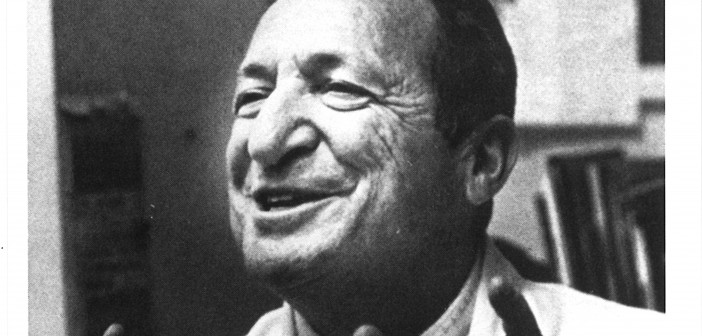Four Decades of Leadership
A decade before Brown University’s medical school became a reality, Brown already had a professor of medicine. Back in 1963, Rhode Island Hospital recognized that its future as a tertiary care medical center, as well as its contemplated role in providing a site for the clinical training of medical students, depended upon the recruitment of a full-time director of an internal medicine service. This appointment would represent the first crucial step in transforming the hospital from a community institution managed by physicians in private practice to one with an expanded role to include medical and health care education at all levels, basic and applied research, as well as rigorous supervision of the care rendered to its patients.
The appointment of a director of internal medicine is typically the first critical undertaking in the transition of a community hospital to an academic medical center. A search committee examined the credentials of many candidates for this critical post. They finally selected a 42-year-old Massachusetts physician, then an assistant professor of medicine at Harvard Medical School and an attending physician at Boston’s Beth Israel Hospital. His name was Milton William Hamolsky.
Hamolsky was born in Lynn, MA (not Milton, MA, as some of his admirers had claimed). He was the son of a local shopkeeper and a member of a close-knit family that cherished learning above all other graces. Milton,
named after his grandfather, Mordecai, attended Harvard College, graduating summa cum laude. He then went on to Harvard Medical School, in 1943.
The nation was in the depths of World War II and medical education was accordingly shorn of all its summer vacations, thus accelerating the process of educating future physicians to three years. Hamolsky received his medical degree in 1946 and his diploma bore those seldom-imprinted words, magna cum laude, signifying his station as the school’s outstanding student.
In the summer of 1946, Hamolsky entered into a long and productive relationship with Beth Israel Hospital, beginning with an internship on the medical service, followed by a threeyear residency that culminated in his appointment as chief resident physician in medicine. In the midst of his graduate training, Hamolsky entered the armed services and was assigned to the Army Medical Research Facility at Fort Knox, KY, where he conducted extensive investigations on the diagnostic and therapeutic uses of newly devised radioactive chemicals in a variety of human diseases. He was discharged in 1950, with the rank of captain, returning then to his beloved Beth Israel Hospital. In 1951, he was appointed both to the hospital’s attending staff and to Harvard’s Department of Medicine. For the succeeding decade he established himself as one of the hospital’s authorities on endocrine diseases, particularly ailments of the thyroid gland. By 1958, he was chief of endocrinology and assistant professor of medicine at Harvard.
During much of this productive interlude, Hamolsky invested his spare time in studying the role of iodine in the metabolism of the thyroid gland, both in normal and abnormal conditions. This investigation was so promising that the Commonwealth Foundation underwrote a research fellowship allowing Hamolsky to devote an entire year (1961-1962) to his investigative pursuits. He chose the College de France, in Paris, to undertake this research, which led to the discovery of a laboratory test, used to this day, as a standard diagnostic procedure in determining the status of thyroid function.
This research brought him to the attention of medical centers beyond Boston. And, in 1963, Rhode Island Hospital recruited him as their physician-in-chief, a position he held until 1987. During those 24 years, he maintained a superb residency training program, certainly the finest in Rhode Island and one of the best in New England. There are, here in Rhode Island and elsewhere in the United States, hundreds of practicing internists who learned both their clinical skills and their high ethical standards from Milton Hamolsky. In addition, he recruited outstanding full-time chiefs of the subspecialties of internal medicine, including cardiology, pulmonary, gastroenterology, and nephrology. In doing so, he created the groundwork for a multidisciplinary clinical service that could easily accommodate the educational needs of a medical school. Brown, in its wisdom, appointed him as professor of medicine in 1963, despite the absence of any medical school, or even a corporate commitment to create one in the foreseeable future.
The application for permission to initiate an accredited academic program leading to the MD degree at Brown University was approved by federal authorities in the summer of 1972; clinical training of a pilot group of 12 students commenced in August of that year.
This was an important, indeed critical, undertaking by the University, something that went beyond mere excellence in laboratory science or lecture hall instruction; this involved the teaching of young men and women in the complex nature of the physician-patient relationship, the rare skill in imparting the truth humanely while conveying clinical instructions with compassion and commitment to the welfare of the patient. Accordingly, this demanded a cadre of teacher-clinicians certainly knowledgeable in their field but in addition both willing and able to teach these humane abilities to others.
These are rare yet vital skills representing the very core of successful medical education, and for this critical task in facilitating the transition from the lecture hall to the bedside, the University relied upon the teaching capabilities of four experienced internists, led by Hamolsky.
Hamolsky’s contributions to health care in Rhode Island extended beyond the portals of Rhode Island Hospital. He was senior consultant to The Miriam Hospital and the Providence VA hospital, served concurrently as chief at Women & Infants Hospital, and worked on countless committees under the aegis of the state government, the state medical society, and private organizations such as Planned Parenthood of Rhode Island. During those active years he also served as chairman of the Rhode Island Heart Association, president of the Rhode Island Diabetes Association, and governor of the American College of Physicians.
In 1987 Hamolsky left Brown to become the chief administrative officer of the state’s Board of Medical Licensure and Discipline. Under his inspired stewardship, the board was transformed into a superbly managed agency that has become a model for other states to emulate. And when the directorship of the Rhode Island Department of Health became vacant, it was Hamolsky who was called upon to briefly assume its leadership.
In 2002, he retired as a practicing physician. He gave the state four decades of dedicated and exemplary leadership as an administrator, as a teacher, and as a wise and humane practitioner. Rhode Island, its medical school, and its teaching hospitals are indebted to that anonymous search committee that, some 40 years ago, brought a gifted physician named Milton Hamolsky to this community.
He was an active board member of Home & Hospice Care of Rhode Island, which honored him with its Human Dignity Award last fall. Beloved by his colleagues, he has numerous awards within the medical community named in his honor, including the Milton Hamolsky Outstanding Physician Award, the highest honor given by the Rhode Island Hospital medical staff to one of its own.
Hamolsky died January 18, 2014, at the age of 92. He is survived by his wife, Sandra Rosman Hamolsky; his children, Deborah Hamolsky, David J. Hamolsky, Joy Scharfman, and Robin Folk, and their spouses; his brother and sister; and six grandchildren. He was predeceased by his son John S. Hamolsky, his grandson Spenser Scharfman, and his first wife, Virginia Maglin Hamolsky.




